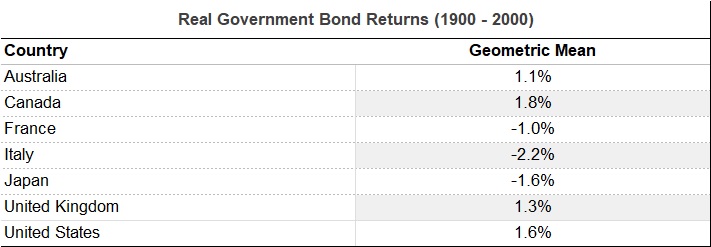Buy Gold, Sell Bonds
Submitted by Silverlight Asset Management, LLC on June 28th, 2019
As the first-half of 2019 draws to a close, investors have much to cheer about. A lot of money has been made across many asset classes.
If you're considering tweaking your strategy for the second-half of the year, I have four words for you: Buy gold, sell bonds.
Why Gold Is Attractive Again
Gold has been dead money since 2011. But lately, it's showing signs of life again. Gold recently broke above an important resistance level at $1,350. Some technicians think this sets the stage for a run to $1,700.
There are several important reasons why money is flowing into gold.
1. Safe haven store of value. It's no coincidence that gold and bitcoin are both taking off this year. Both also spiked in 2016, which is the last time European bond yields drifted into negative territory. As long as the world's central bankers stay committed to QE, currency wars, and other endeavors that involve unlimited money printing, then alternative currencies like gold and bitcoin will likely maintain a strong bid.
Gold is particularly appealing because:
- It's less volatile than crypto currencies.
- There is a 5,000 year track record as a reliable store of value.
- Supply is constrained. For perspective, you could fit all the gold ever mined throughout history into just two Olympic-sized swimming pools.
- Gold also has a low correlation to equities and bonds, making it an efficient diversification tool.
2. Dollar hedge. Many commodities like gold are priced in dollars. So when the dollar weakens, commodity prices tend to rise.
The U.S. dollar has outperformed global currencies in recent years. Based on recent remarks and tweets, President Trump clearly wants that trend to end.
Presidents tend to get the dollar they desire via their influence over the Treasury Department and Fed. This President wants a weak currency to help mitigate economic fallout from the trade war. Gold will likely do well if the Trump Administration succeeds in pushing the dollar lower.
3. Central bank buying. The dollar is the world's primary reserve currency, but a number of countries might like to see that change.
Russia, for example, cut the dollar from 46% of its international reserve in 2017 to 23% in 2018. To make up the difference, Russia increased the share of euros, renminbi and gold.
The World Gold Council has noted an increase in net gold purchases by other central banks as well. In the first quarter of 2019, central banks bought a record amount of gold (715 metric tons). China is following suit, increasing its gold reserves for a sixth straight month in May.
Geopolitical and trade frictions aside, there is a rationale for why foreigners may want to pare back on U.S. debt. That's because the fiscal deficit is projected to explode higher in the coming years.
Source: Congressional Budget Office
A perfect way to fund a gold investment might be selling down your bond exposure.
Bonds Aren't Always A Safe Investment
Many perceive bonds to be a "safe" investment, suitable for conservative investors. But is that true at any price?
At this point, the prospects for earning positive real returns in many fixed income securities over a long-term horizon appear dim.
1. Negative Yields. If the Fed and ECB want lower long-term rates, they're getting their wish. The U.S. 10-year yield has descended to 2.0%, while Germany's 10-year trades at a record low yield of -0.3%. Per Bloomberg, approximately 25% of global bonds presently trade at negative yields.
Source: Bloomberg
What could possibly be safe about investments guaranteed to lose money?
Another striking example relates to the Republic of Austria. Two years ago, Austria issued a 100-year bond at a 2.1% coupon rate. To buy those 2117 Austria bonds today would require paying 60% over the issue price, which means settling for a yield of just 1.1%.
100-years worth of interest rate risk, in exchange for a 1.1% yield. Think about that for a moment.
People often talk of "euphoric sentiment" being a sign of equity cycle tops. Might we be seeing that now in bonds?
2. Bonds Have Bear Markets, Too. Speaking of 100 years, if you survey the last century, bond returns weren't exactly sterling.
Below is a table showing a sample of average real returns from 1900 - 2000. All the countries shown exhibited positive real returns in their equity markets, but not their fixed income markets. Even in the U.S., real returns were only 1.6% per year.

Sources: Investopedia, "Triumph of the Optimists" by Dimson, Marsh and Staunton.
It's one thing to say bonds aren't a great long-term investment. But what if you also layer on today's yield environment?
I'd like to take you back to the year 1951. The 10-year treasury yielded about 2.0%—similar to now. The Fed had pegged interest rates at an artificially low level to help finance government debt during World War II. After those restrictions were lifted, the U.S. bond market commenced a secular bear market that saw the 10-year yield rise to 15% by 1981.
30 years of negative real returns is hard for many of today's bond investors to fathom. But it could happen. It's happened before.
Thousands of investors currently have their retirement nest egg parked in Retirement Target Date Funds, which allocate more to bonds as folks age. The allocation doesn't factor in valuations. And that doesn't pass the common sense test.
Bonds were clearly much riskier in 1951 compared to in 1981, because the yield profiles were totally different. Following similar logic, bonds are riskier today than they were in 1981.
So if you own bonds, consider taking some profit. Be thankful for the excellent total return you likely achieved.
Might I be early in making a call to fade bonds? Sure. But now is a good time to take a shot at rotation.
Numerous technical indicators suggest bond yields may bottom soon. As just one example, below is a weekly chart of the 10-year yield, overlaying an indicator called TD Sequential. The red 13 appearing this week suggests the bearish trend in yields may be nearing an exhaustion point, setting the stage for a reversal.

Sources: DeMark Analytics, Bloomberg
***
A key point to remember is: bull markets are the authors of bear markets.
In a bull market, valuations become stretched, which lays the seeds for an eventual bear market. You can apply that simple nugget of wisdom to stocks, bonds, or any other asset in which valuation plays a role.
So take your pick. What's really a safe haven investment at this stage?
Originally published by Forbes. Reprinted with permission.
This material is not intended to be relied upon as a forecast, research or investment advice. The opinions expressed are as of the date indicated and may change as subsequent conditions vary. The information and opinions contained in this post are derived from proprietary and nonproprietary sources deemed by Silverlight Asset Management LLC to be reliable, are not necessarily all-inclusive and are not guaranteed as to accuracy. As such, no warranty of accuracy or reliability is given and no responsibility arising in any other way for errors and omissions (including responsibility to any person by reason of negligence) is accepted by Silverlight Asset Management LLC, its officers, employees or agents. This post may contain “forward-looking” information that is not purely historical in nature. Such information may include, among other things, projections and forecasts. There is no guarantee that any of these views will come to pass. Reliance upon information in this post is at the sole discretion of the reader.
Testimonials Content Block
More Than an Investment Manager—A Trusted Guide to Financial Growth
"I’ve had the great pleasure of having Michael as my investment manager for the past several years. In fact, he is way more than that. He is a trusted guide who coaches his clients to look first at life’s bigger picture and then align their financial decisions to support where they want to go. Michael and his firm take a unique and personal coaching approach that has really resonated for me and helped me to reflect upon my core values and aspirations throughout my investment journey.
Michael’s focus on guiding the "why" behind my financial decisions has been invaluable to me in helping to create a meaningful strategy that has supported both my short-term goals and my long-term dreams. He listens deeply, responds thoughtfully, and engages in a way that has made my investment decisions intentional and personally empowering. With Michael, it’s not just about numbers—it’s about crafting a story of financial growth that has truly supports the life I want to live."
-Karen W.
Beyond financial guidance!
"As a long-term client of Silverlight, I’ve experienced not only market-beating returns but also invaluable coaching and support. Their guidance goes beyond finances—helping me grow, make smarter decisions, and build a life I truly love. Silverlight isn’t just about wealth management; they’re invested in helping me secure my success & future legacy!"
-Chris B.
All You Need Know to Win
“You likely can’t run a four-minute mile but Michael’s new book parses all you need know to win the workaday retirement race. Readable, authoritative, and thorough, you’ll want to spend a lot more than four minutes with it.”
-Ken Fisher
Founder, Executive Chairman and Co-CIO, Fisher Investments
New York Times Bestselling Author and Global Columnist.
Packed with Investment Wisdom
“The sooner you embark on The Four-Minute Retirement Plan, the sooner you’ll start heading in the right direction. This fun, practical, and thoughtful book is packed with investment wisdom; investors of all ages should read it now.”
-Joel Greenblatt
Managing Principal, Gotham Asset Management;
New York Times bestselling author, The Little Book That Beats the Market
Great Full Cycle Investing
“In order to preserve and protect your pile of hard-earned capital, you need to be coached by pros like Michael. He has both the experience and performance in The Game to prove it. This is a great Full Cycle Investing #process book!”
-Keith McCullough
Chief Executive Officer, Hedgeye Risk Management
Author, Diary of a Hedge Fund Manager
Clear Guidance...Essential Reading
“The Four-Minute Retirement Plan masterfully distills the wisdom and experience Michael acquired through years of highly successful wealth management into a concise and actionable plan that can be implemented by everyone. With its clear guidance, hands-on approach, and empowering message, this book is essential reading for anyone who wants to take control of their finances and secure a prosperous future.”
-Vincent Deluard
Director of Global Macro Strategy, StoneX

